Development of a Remote-Controlled Electrical Interference Vehicle with a Magnetron
Abstract
:1. Introduction
2. The Concept of the Remote-Controlled Mobile Interference Device
2.1. Block Diagram of the Remote-Controlled Mobile Interference Device
- Transmission mode
- Reception mode
2.2. The Transmitting Part—Interference
2.2.1. Description of the Transmitting Part
2.2.2. Design of the Interference Antenna
2.3. Receiving Part
3. Results of Experiments
3.1. Checking the Interference
- P - power density acting on the disrupted device [W/m2],
- PT - transmitted power by magnetron,
- GT - gain of transmitting antenna,
- RT - distance of the interfering apparatus from the disrupted device [m],
- 4.π. RT2 - area of the sphere whose center is located at the place of the interfering apparatus, where its radius is given by the distance of the interfering apparatus from the disrupted device.
3.2. Testing Reception
3.3. Testing the Drive
4. Discussion
4.1. Antenna for Interference
4.2. Powering the Magnetron
4.3. Drive
4.4. Overall Results of Optimisation
5. Conclusions
Author Contributions
Funding
Acknowledgments
Conflicts of Interest
References
- Ali, A.H.; Razak, M.R.A.; Hidayab, M.; Azman, S.A.; Jasmin, M.Z.M.; Zainol, M.A. Investigation of indoor WIFI radio signal propagation. In Proceedings of the IEEE Symposium on Industrial Electronics & Applications, Penang, Malaysia, 3–5 October 2010; ISBN 978-1-4244-7647-3. [Google Scholar]
- Huang, Z.; Xu, L.; Lin, Y. Multi-Stage Pedestrian Positioning Using Filtered WiFi Scanner Data in an Urban Road Environment. Sensors 2020, 20, 3259. [Google Scholar] [CrossRef] [PubMed]
- Poularakis, K.; Losifidis, G.; Tassiulas, L. Joint Deployment and Pricing of Next-Generation WiFi Networks. IEEE Trans. Commun. 2019, 69, 6193–6205. [Google Scholar] [CrossRef]
- Greu, V.; Ciotîrnae, P.; Popescu, F.; Burgos, M.G.; Sima, I. Model and algorithm for the estimation of internal/environmental interference influence and improvement of IEEE 802.11/WiFi networks performance, using passive monitoring. In Proceedings of the International Conference on Communications, Bucharest, Romania, 29–31 May 2014; ISBN 978-1-4799-2385-4. [Google Scholar]
- Zhao, L.; Wan, L. A New Deep Learning Architecture for Person Detection. In Proceedings of the International Conference on Computer and Communications, Chengdu, China, 6–9 December 2019; ISBN 978-1-7281-4744-4. [Google Scholar]
- Regalbuto, E.; Anselmo, A.; De Sanctis, S.; Franchihi, V.; Lista, F.; Benvenuto, M.; Bei, R.; Musuelli, L.; Dínzeo, G.; Paffi, A.; et al. Human Fibroblasts In Vitro Exposed to 2.45 GHz Continuous and Pulsed Wave Signals: Evaluation of Biological Effects with a Multimethodological Approach. Sensors 2020, 21, 7069. [Google Scholar] [CrossRef] [PubMed]
- Yang, Y.; Dai, P.; Huang, H.; Wang, M.; Kuang, Y. A Semi-Simulated RSS Fingerprint Construction for Indoor Wi-Fi Positioning. Sensors 2020, 9, 1568. [Google Scholar]
- Leuchter, J.; Quang, D.H. Design of Interfering Mobile Device in the Band Wi-Fi with Magnetron. Adv. Electr. Electron. Eng. 2018, 16, 4. [Google Scholar] [CrossRef]
- Leonhard, W. Control of Electrical Drives, 3rd ed.; Springer: Berlin, Germany, 2001; ISBN 3-540-41820-2. [Google Scholar]
- Mohan, N. Electric Drives: An Integrative Approach; MNPERE: Minneapolis, MN, USA, 2000; ISBN 978-0971529250. [Google Scholar]
- Miah, A.S.M.; Rahim, M.A.; Shin, J. Motor-Imagery Classification Using Riemannian Geometry with Median Absolute Deviation. Electronics 2020, 9, 1584. [Google Scholar]
- Daowd, M.; Omar, O.; Verbrugge, B.; Bossche, P.V.D.; Mierlo, J.V. Battery Models Parameter Estimation based on Matlab/Simulink®. In Proceedings of the 25th World Battery, Hybrid and Fuel Cell Electric Vehicle Symposium & Exhibition, Shenzhen, China, 7–9 November 2010. [Google Scholar]
- Deslandes, D.; Wu, K. Analysis and design of current probe transition from grounded coplanar to substrate integrated rectangular waveguides. IEEE Trans. Microw. Theory Tech. 2005, 53, 2487–2494. [Google Scholar] [CrossRef]
- Sanguino, T.D.J.M.; Ramos, J.E.G. Smart Host Microcontroller for Optimal Battery Charging in a Solar-Powered Robotic Vehicle. IEEE/ASME Trans. Mechatron. 2013, 18, 1039–1049. [Google Scholar] [CrossRef]
- Schmitz, A.; Rick, T.; Karolski, T.; Kuhlen, T.; Kobbelt, L. Efficient Rasterization for Outdoor Radio Wave Propagation. IEEE Trans. Vis. Comput. Graph. 2011, 17, 159–170. [Google Scholar] [CrossRef] [Green Version]
- Corti, F.; Laudani, A.; Lozito, G.M.; Reatti, A. Computationally Efficient Modeling of DC-DC Converters for PV Applications. Energies 2020, 13, 5100. [Google Scholar]
- Zhao, Q.; Lee, F.C. High-efficiency, high step-up DC-DC converters. IEEE Trans. Power Electron. 2003, 18, 65–73. [Google Scholar] [CrossRef] [Green Version]
- Leuchter, J.; Quang, D.H. Development of mobile electrical vehicle for EMI applications. J. Eng. 2019, 17, 3660. [Google Scholar] [CrossRef]
- Liu, Y.; Li, X.; Li, H.; Wang, J.; Fan, X. Experimental and Numerical Investigation of the Internal Temperature of an Oil-Immersed Power Transformer with DOFS. Appl. Sci. 2020, 10, 5718. [Google Scholar] [CrossRef]
- Liu, Y.; Li, X.; Li, H.; Fan, X. Global Temperature Sensing for an Operating Power Transformer Based on Raman Scattering. Sensors 2020, 20, 4903. [Google Scholar] [CrossRef]
- Kiryukhantsev-Korneev, P.V.; Sytchenko, A.D.; Vorotilo, S.A.; Klechkovskaya, V.V.; Lopatin, V.Y.; Levashov, E.A. Structure, Oxidation Resistance, Mechanical, and Tribological Properties of N- and C-Doped Ta-Zr-Si-B Hard Protective Coatings Obtained by Reactive, D.C. Magnetron Sputtering of TaZrSiB Ceramic Cathode. Sensors 2020, 10, 946. [Google Scholar]
- Gong, L.; Fu, Y.; Chan, K.Y.; Nanzer, J.A. An SIW Horn Antenna Fed by a Coupled Mode Emulating Pyramidal Horn Antennas. IEEE Trans. Antennas Propag. 2019, 68, 33–42. [Google Scholar] [CrossRef]
- Sabban, A. Low-Visibility Antennas for Communication Systems; CRC Press: London, England, 2017; ISBN 9781138748101. [Google Scholar]
- Ismail, W.; Murad, S.A.Z.; Jiat, T.J.; Mandeep, J.S. Integrated power dividing antenna receivers. Microw. J. 2009, 52, 88–106. [Google Scholar]
- Balanis, C.A. Antenna Theory: Analysis and Design, 3rd ed.; John Wiley & Sons Inc.: Hoboken, NJ, USA, 2005; ISBN 0-471-66782-X. [Google Scholar]
- Sammour, I.; Chalhoub, G. Evaluation of Rate Adaptation Algorithms in IEEE 802.11 Networks. Electronics 2020, 9, 1436. [Google Scholar] [CrossRef]
- Popela, M.; Leuchter, J.; Cu, X.P. The Test and Verification of Parameters of Particular Radars Using a MRP-4M. In Proceedings of the International Conference on Military Technologies, Brno, Czech Republic, 30–31 May 2019; ISBN 978-1-7281-4593-8. [Google Scholar]
- Veselý, J.; Hubáček, P.; Olivová, J. The Power Gain Difference Method Analysis. Sensors 2020, 20, 3018. [Google Scholar] [CrossRef]
- Skolnik, M.I. Radar Handbook, 2nd ed.; McGraw-Hill: New York, NY, USA, 1990; ISBN 0-07-066572-9. [Google Scholar]
- Mohan, N.; Undeland, T.M.; Robbins, W.P. Power Electronics, Converters, Applications and Design; John Wiley & Sons, Inc.: Hoboken, NJ, USA, 2003; EAN 9780471226932. [Google Scholar]
- Mohan, N. Power Electronics a First Course; University of Minnesota: Minneapolis, MN, USA, 2011; ISBN 978-1-118-07480-0. [Google Scholar]
- Salema, M.; Jusoha, A.; Rumzi, N.; Idrisa, N.; Dasa, H.S. Resonant power converters with respect to passive storage (LC) elements and control techniques. Renew. Sustain. Energy Rev. 2018, 91, 504–520. [Google Scholar] [CrossRef]
- Zhou, P.; Fang, X.; Fang, Y.; Long, Y.; He, R.; Han, X. Enhanced Random Access and Beam Training for Millimeter Wave Wireless Local Networks with High User Density. IEEE Trans. Wirel. Commun. 2017, 16, 7760–7773. [Google Scholar] [CrossRef]
- Garcia-Loygorri, J.M.; Goikoetxea, J.; Echeverria, E.; Arriola, A.; Val, I.; Sand, S.; Unterhuber, P.; Rio, F.D. The Wireless Train Communication Network: Roll2Rail Vision. IEEE Veh. Technol. Mag. 2018, 13, 135–143. [Google Scholar] [CrossRef]
- Leuchter, J.; Bauer, P.; Zobaa, A.F.; Bojda, P. An Interface Converter of Hybrid Power Sources with Supercapacitors. In Proceedings of the 36th Annual Conference on IEEE Industrial Electronics Society, Glendale, CA, USA, 7–10 November 2010; ISBN 978-1-4244-5226-2. [Google Scholar]
- Wei, X.; Zhao, X.; Dai, H. The application of flyback DC/DC converter in Li-ion batteries active balancing. In Proceedings of the IEEE Conference on Vehicle Power and Propulsion, Dearborn, MI, USA, 7–11 September 2009; ISBN 978-1-4244-2600-3. [Google Scholar]
- Huy, D.Q.; Leuchter, J. Design of Test-system for EMC Investigations of Systems with Magnetron. In Proceedings of the International Exhibition and Conference for Power Electronics, Intelligent Motion, Renewable Energy and Energy Management, Nuremberg, Germany, 16–18 May 2017; ISBN 978-3-8007-4424-4. [Google Scholar]
- Guerra, V.; Ticay-Rivas, J.R.; Alonso-Eugenio, V.; Perez-Jimenez, R. Characterization and Performance of a Thermal Camera Communication System. Sensors 2020, 20, 328. [Google Scholar] [CrossRef] [PubMed]
- Erickson, R.W.; Maksimovic, D. Fundamentals of Power Electronics, 2nd ed.; Springer Science and Business Media LLC: Berlin/Heidelberg, Germany, 2001; ISBN 0792372700. [Google Scholar]
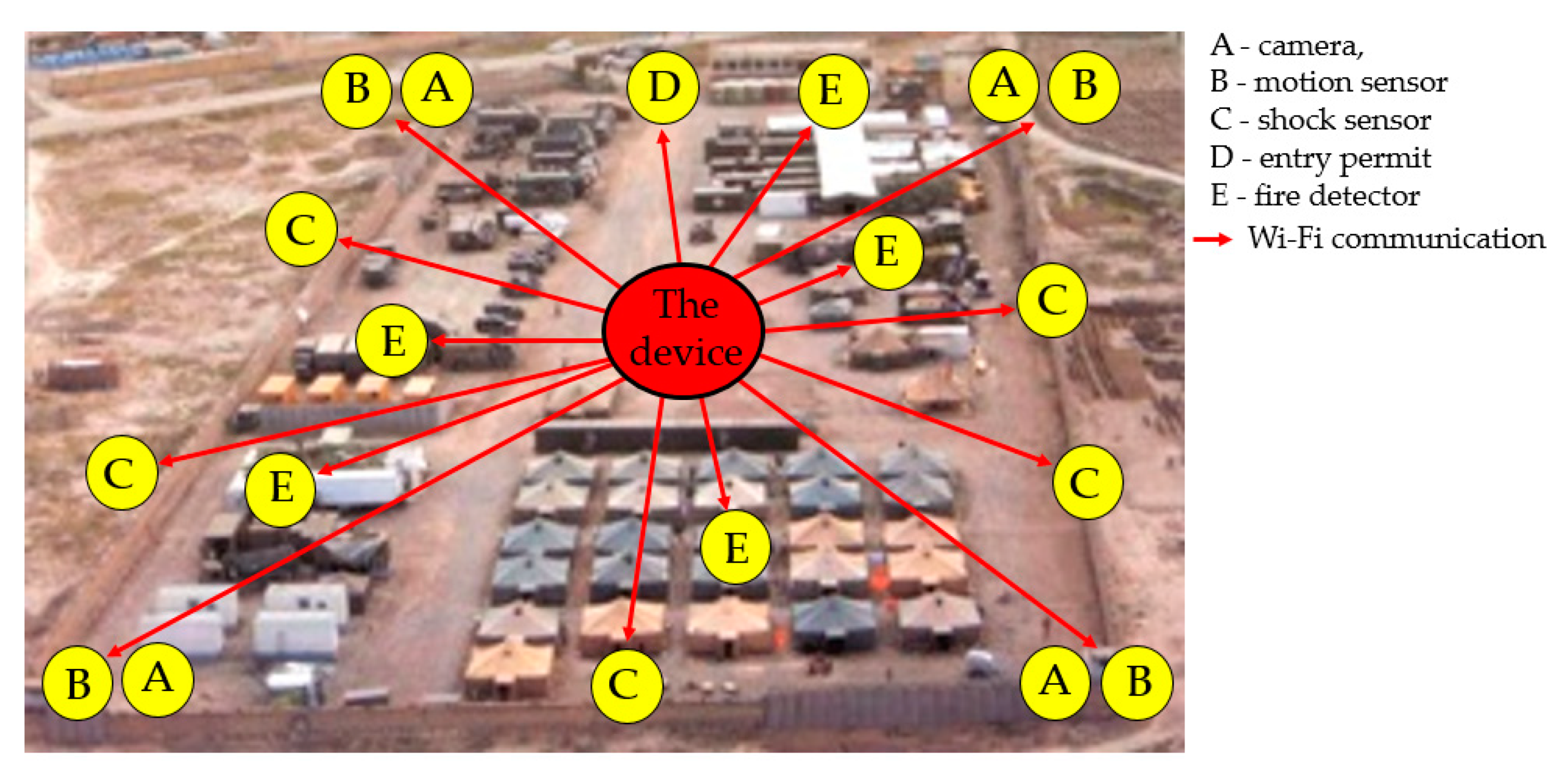
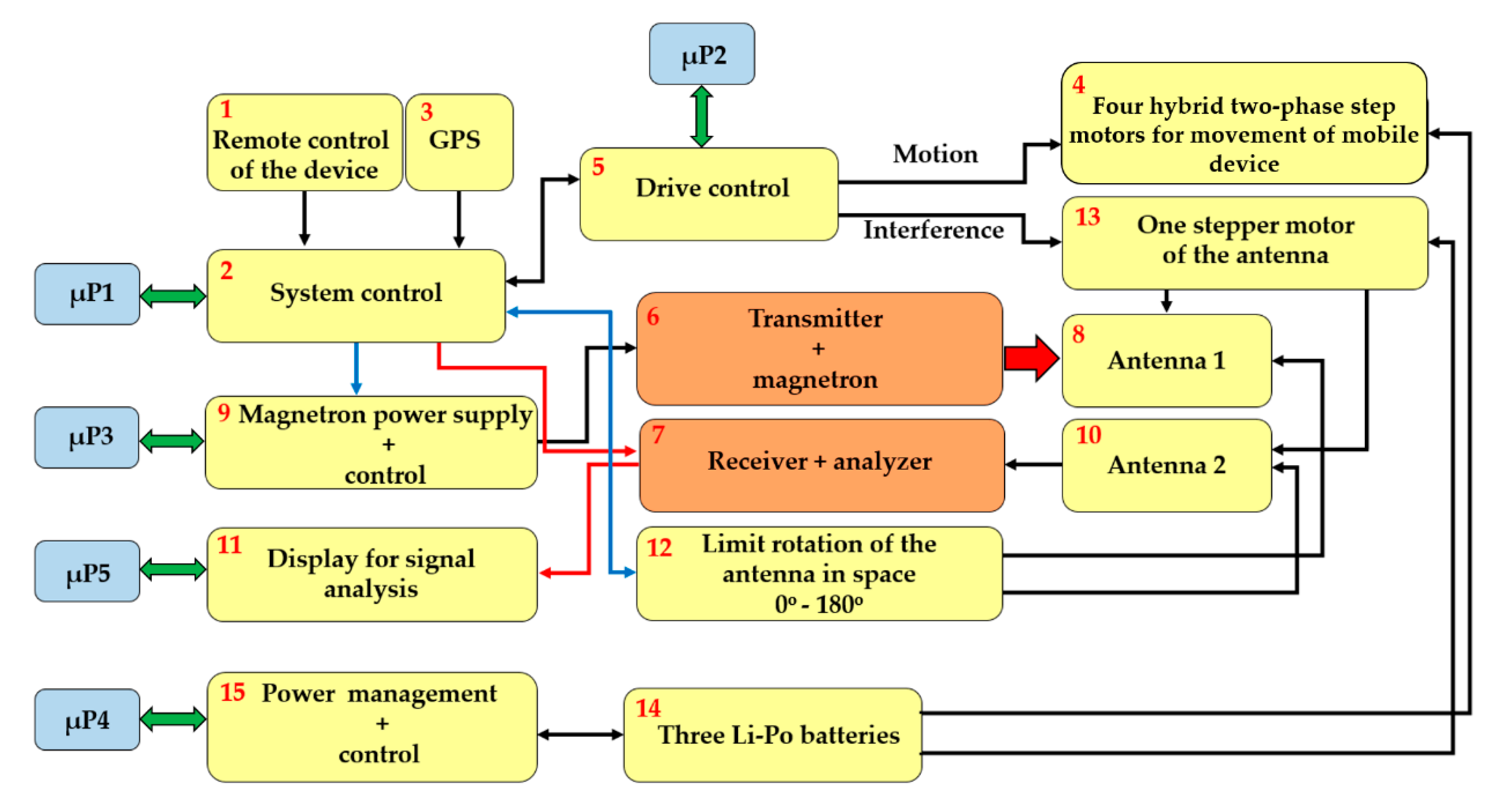
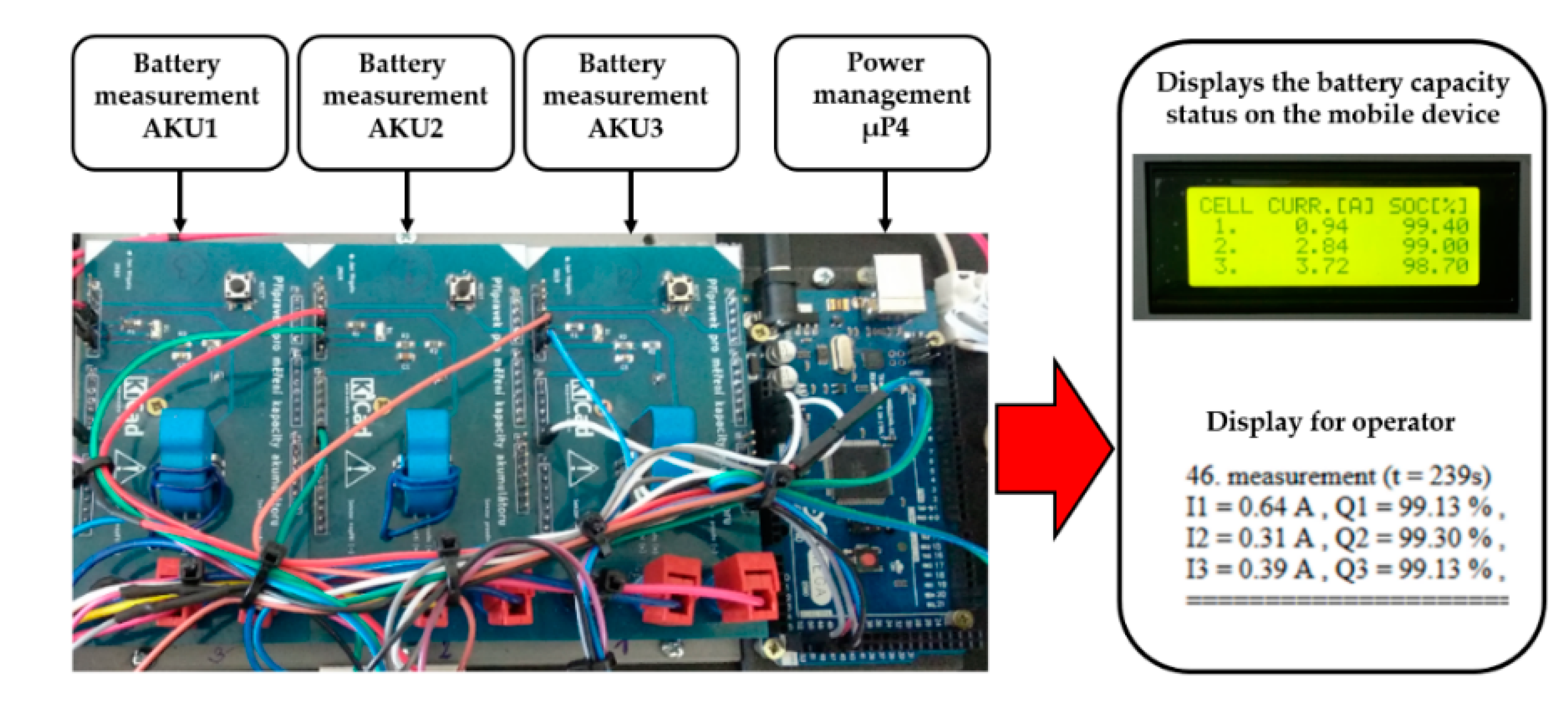



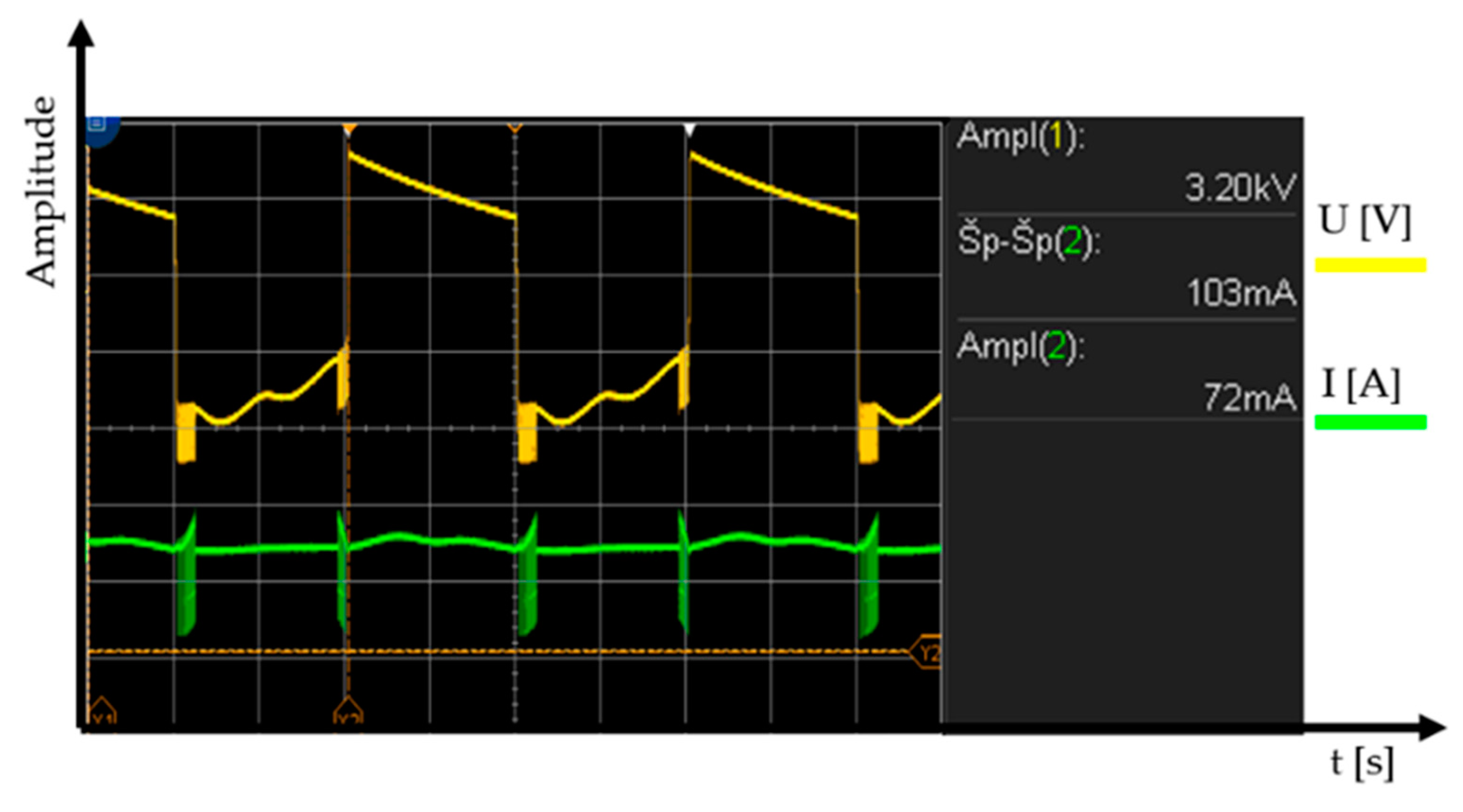
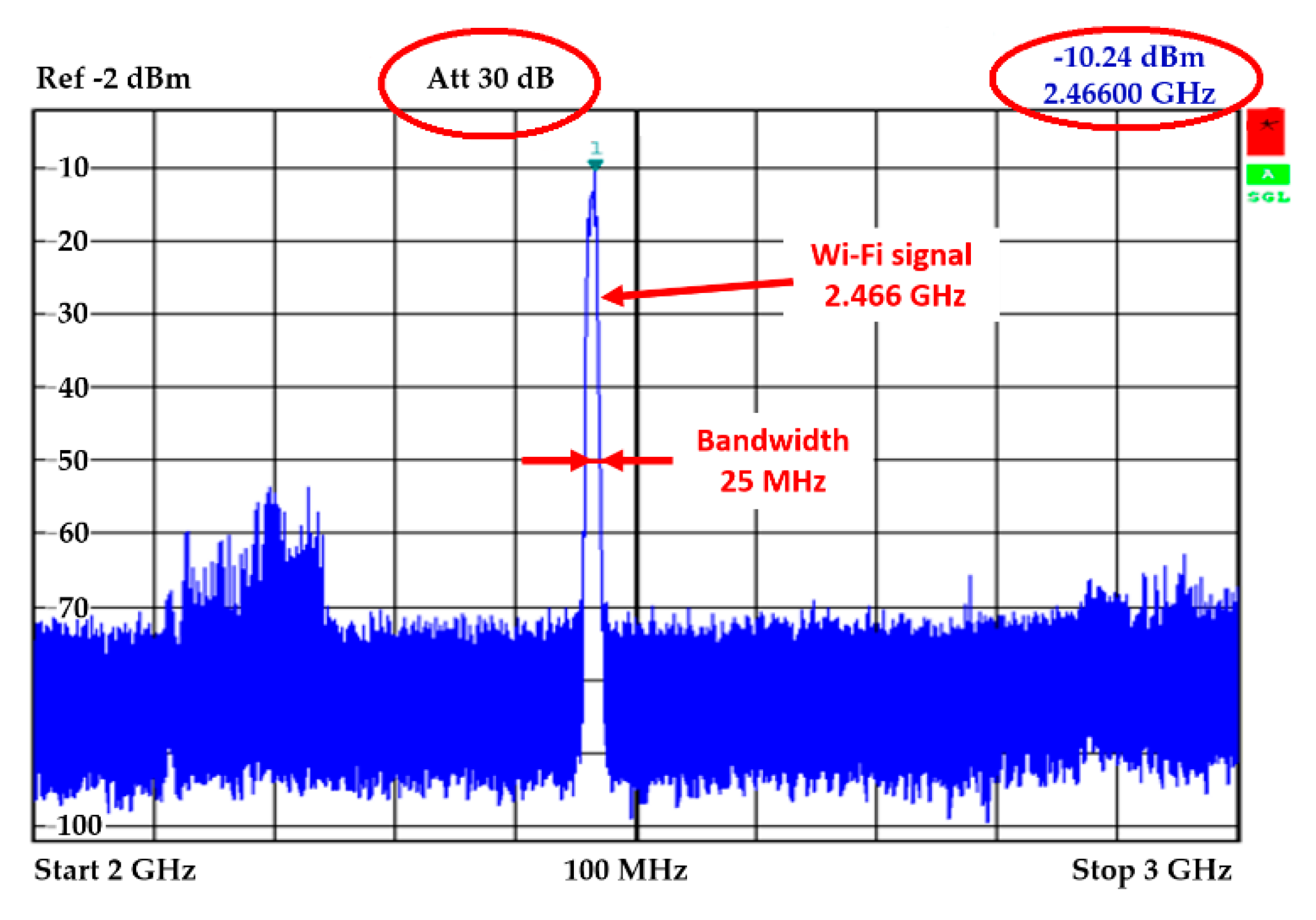


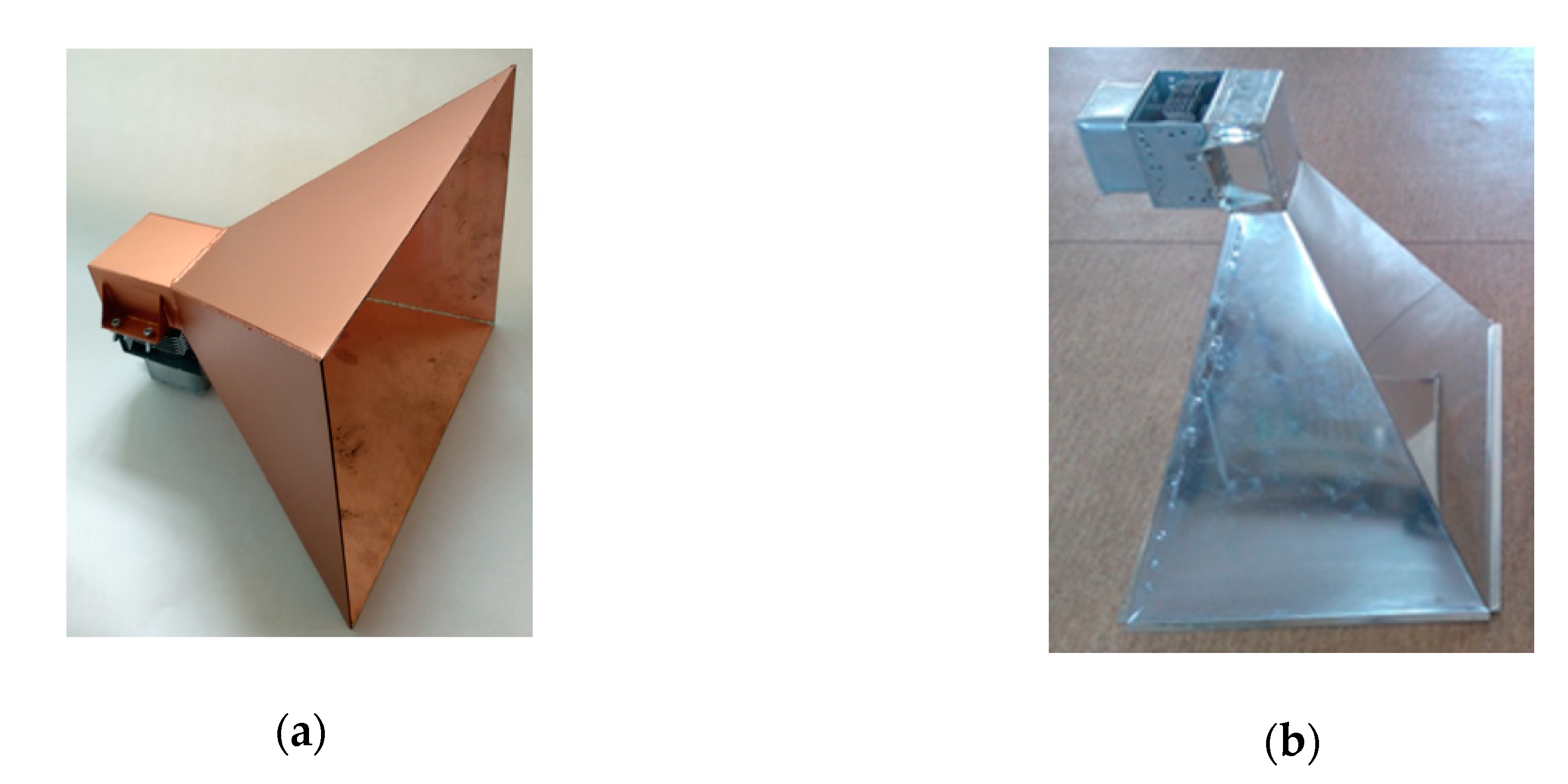
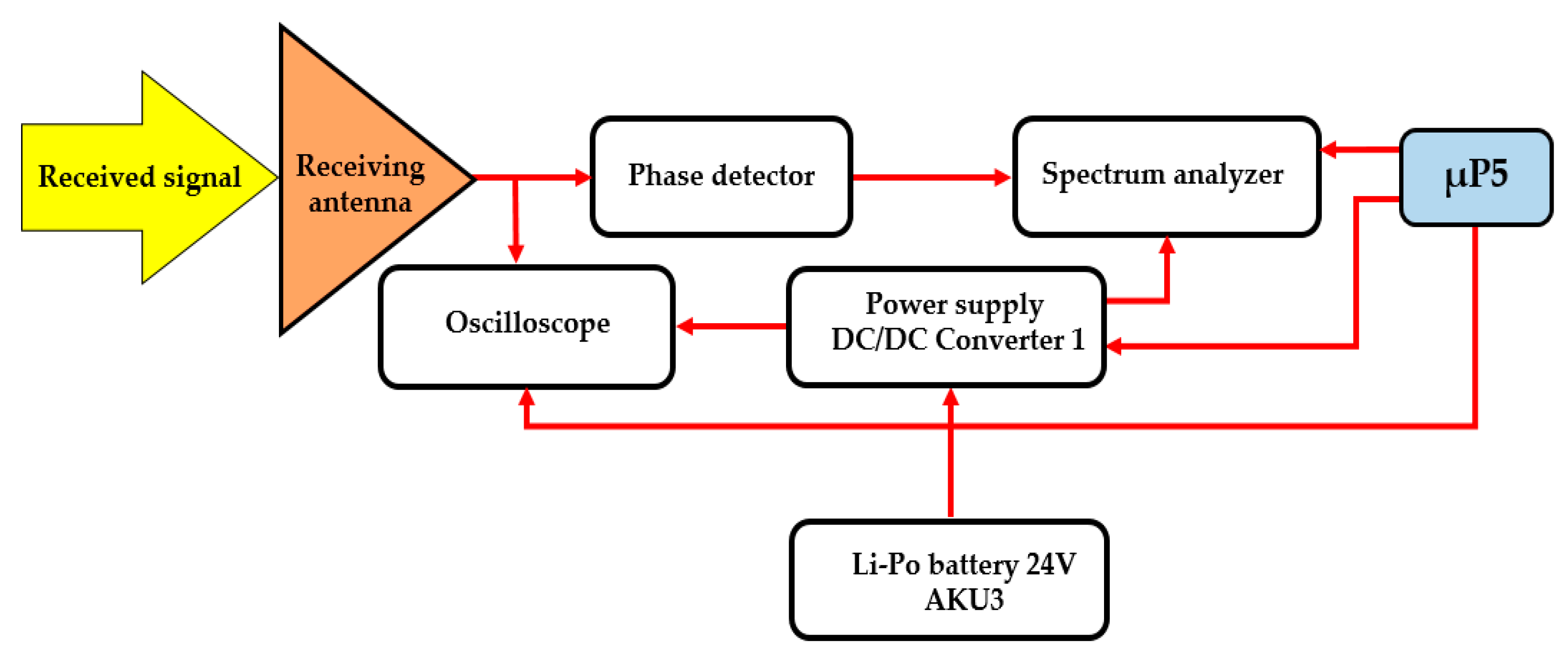

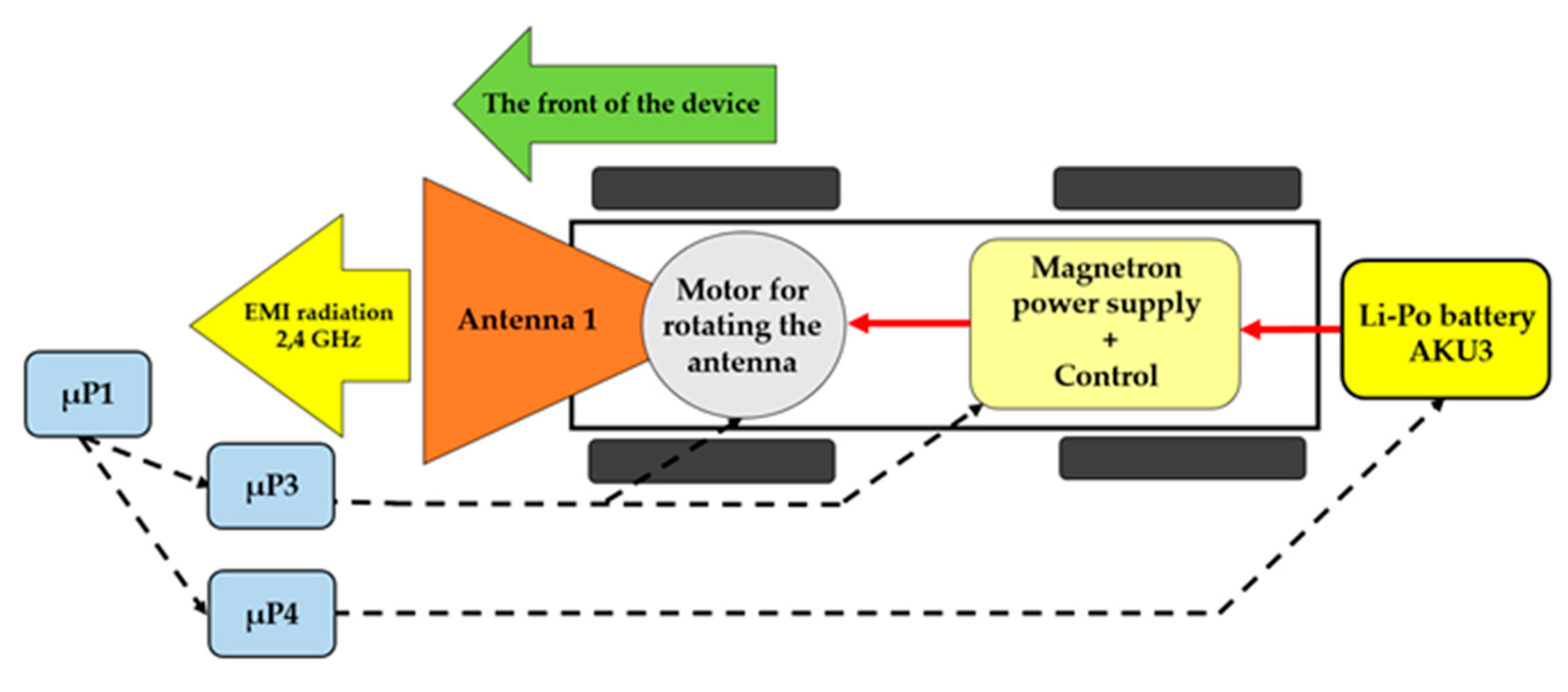
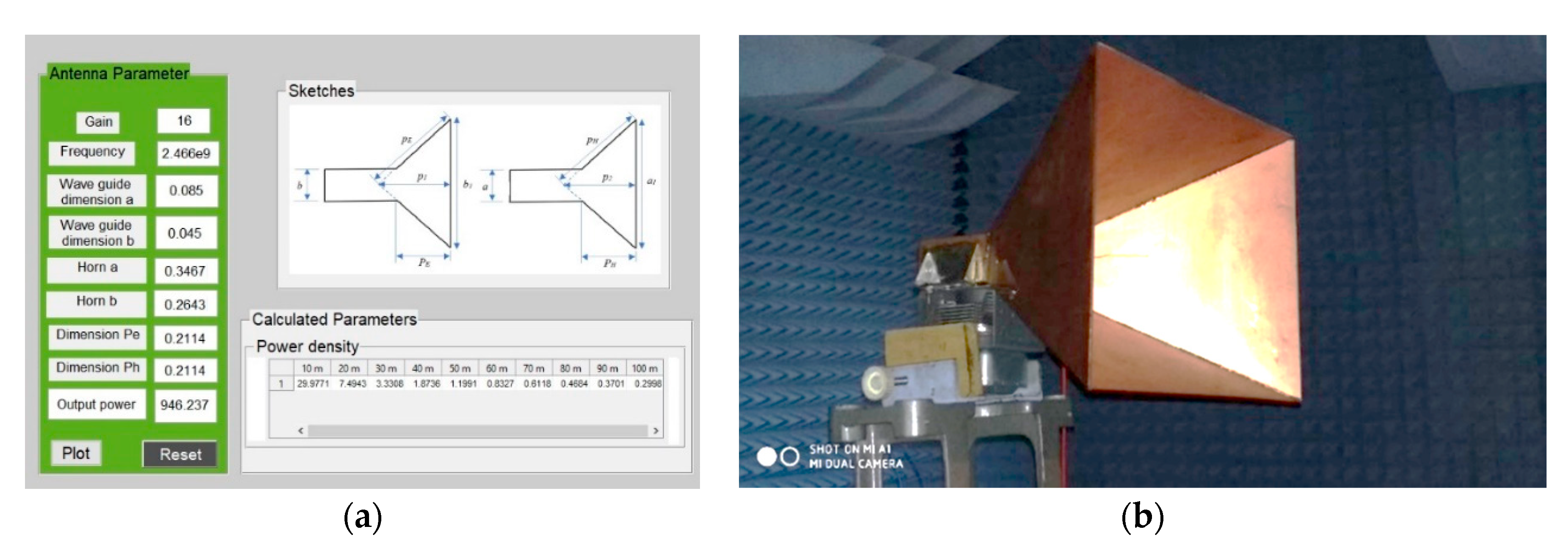

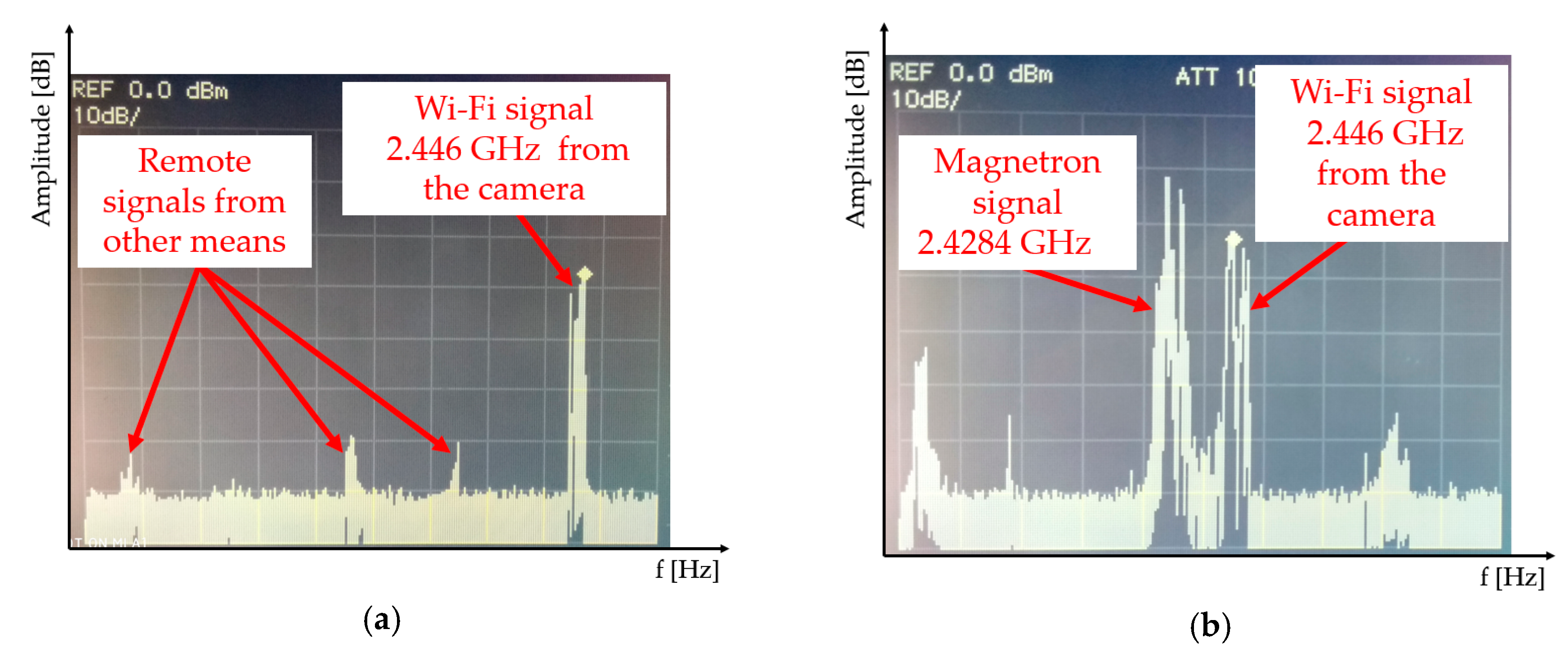
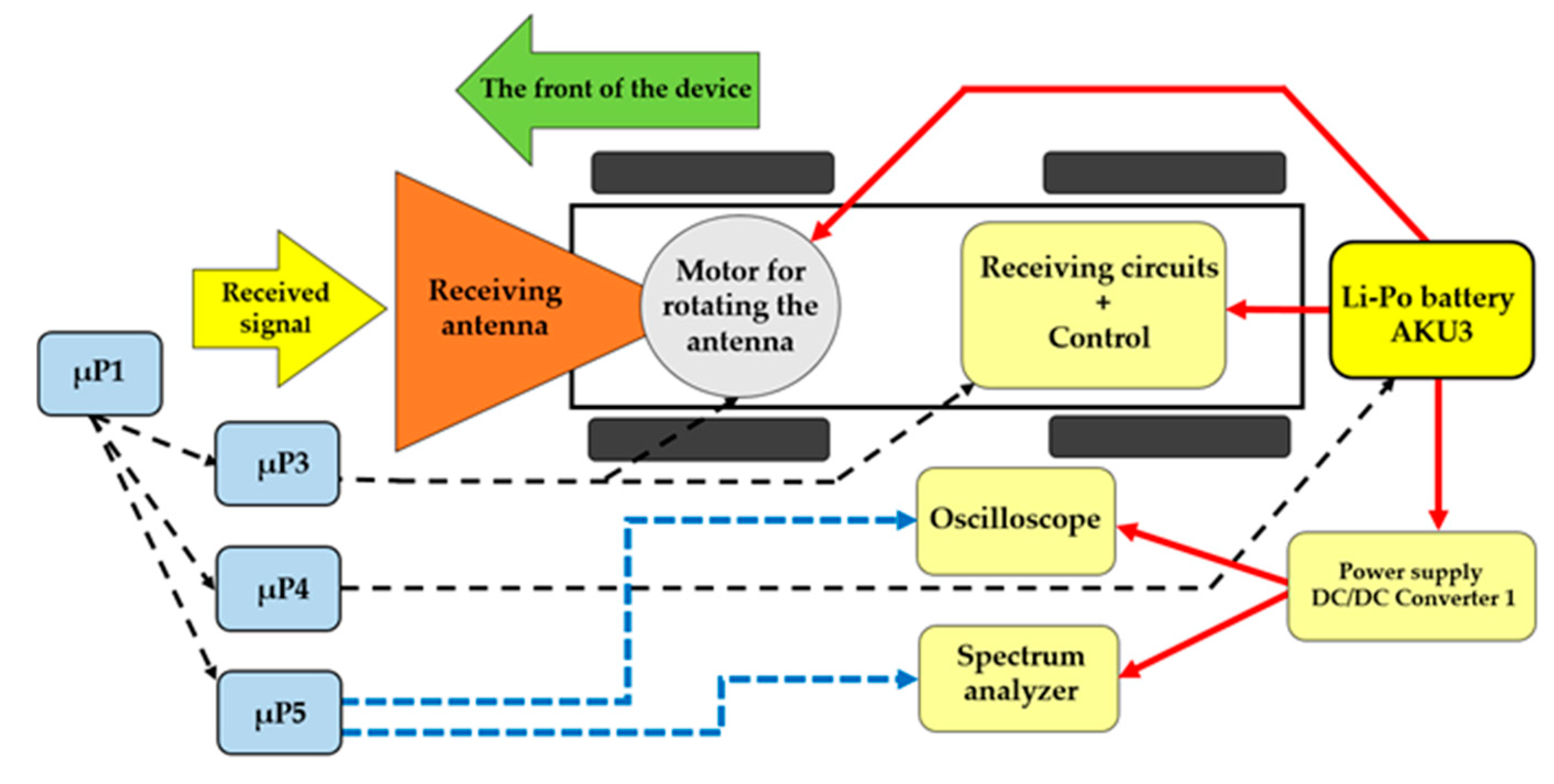
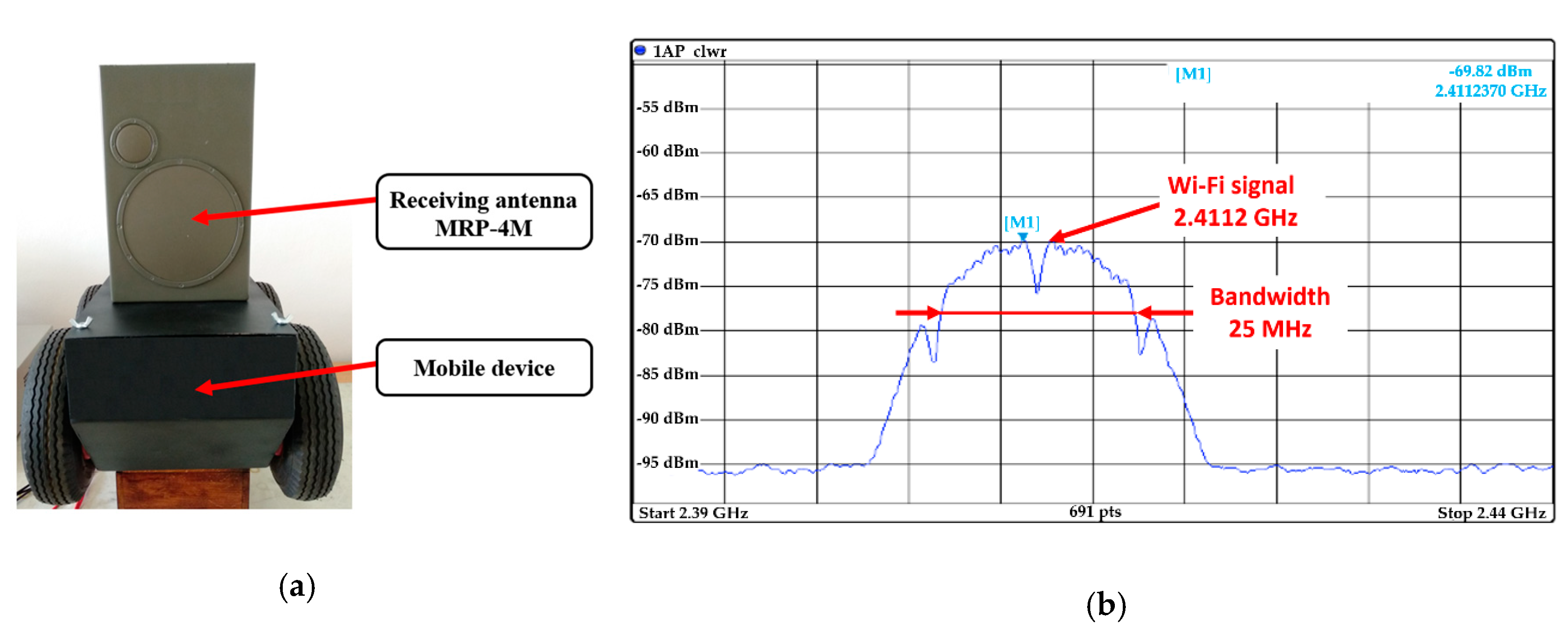
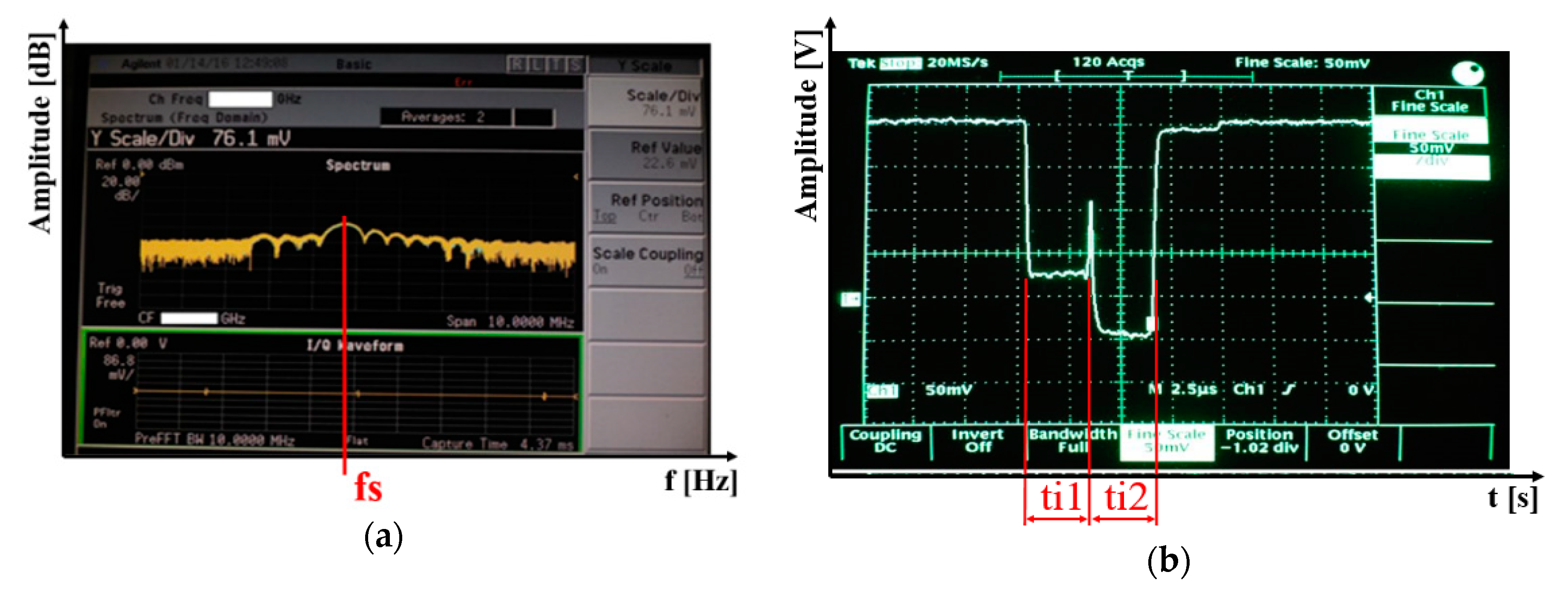



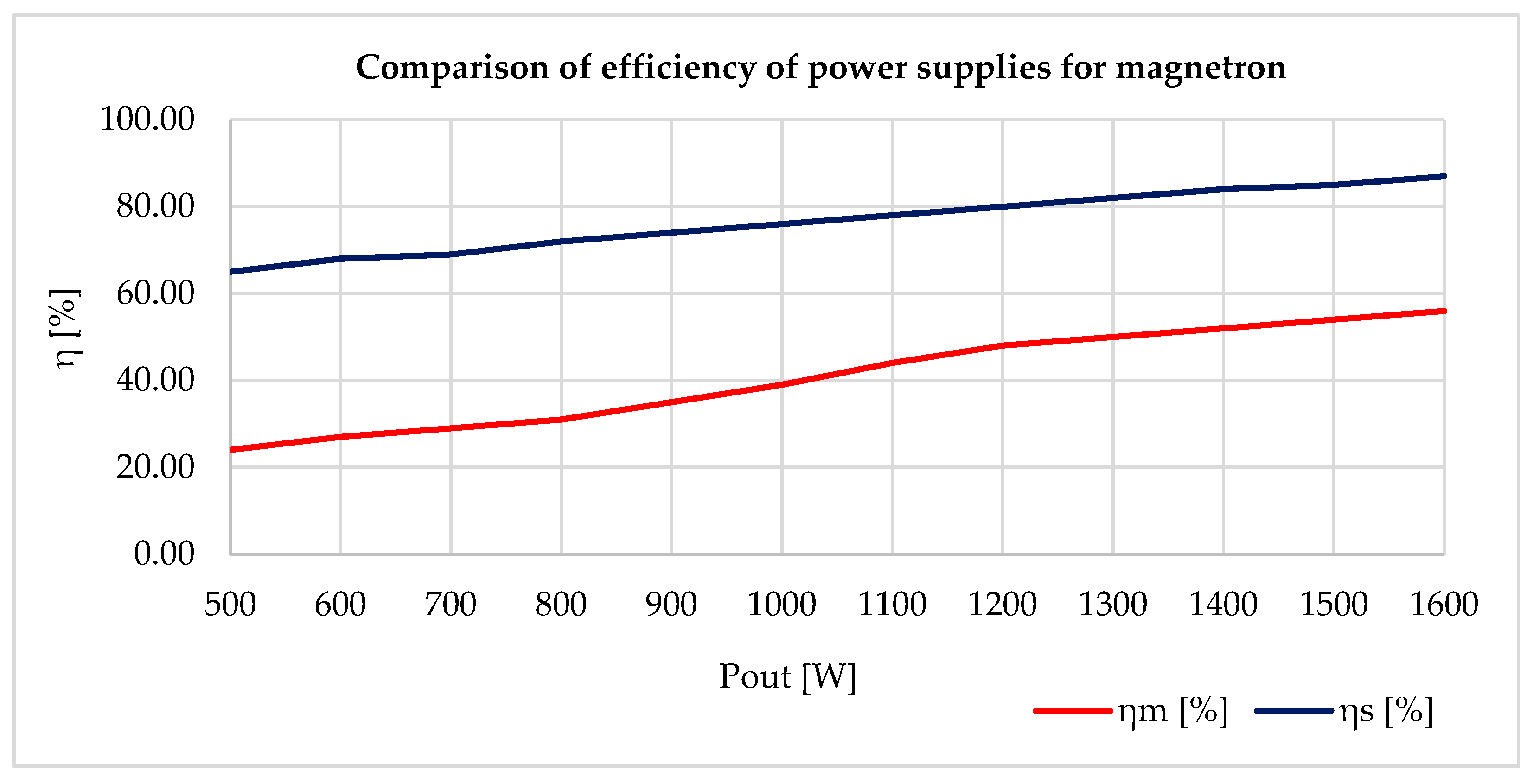
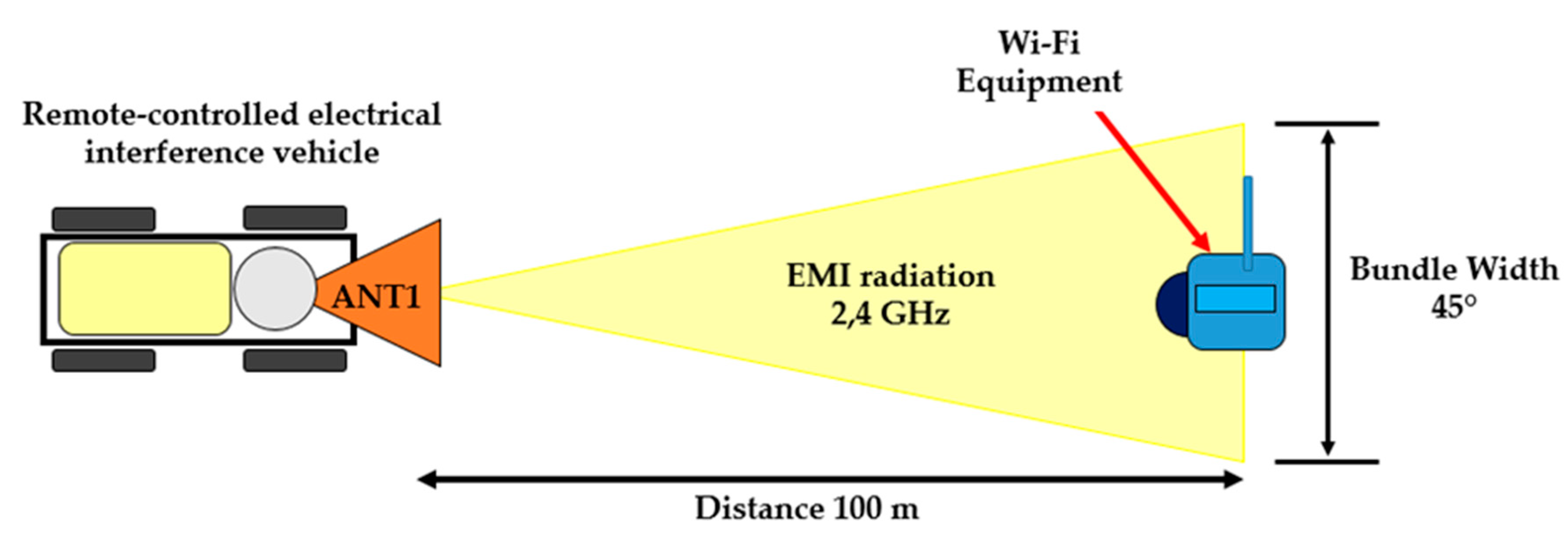
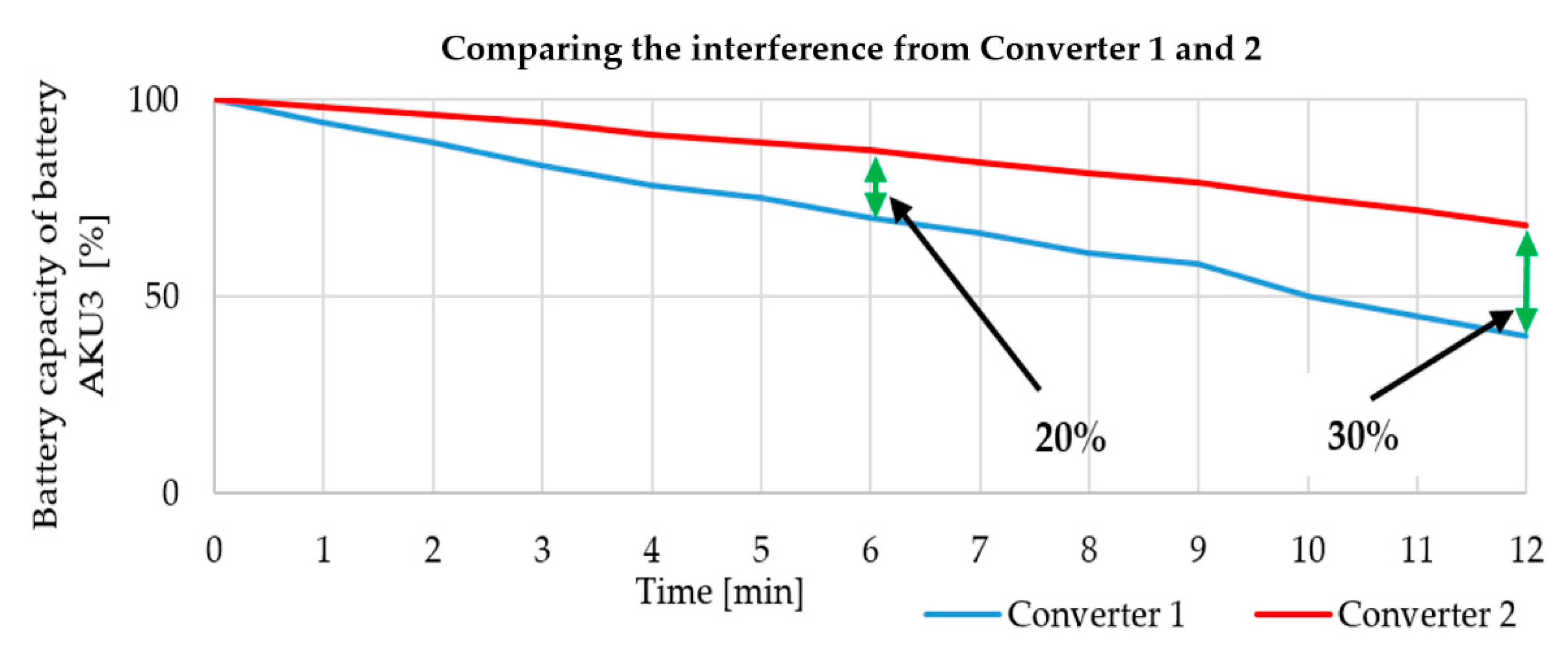
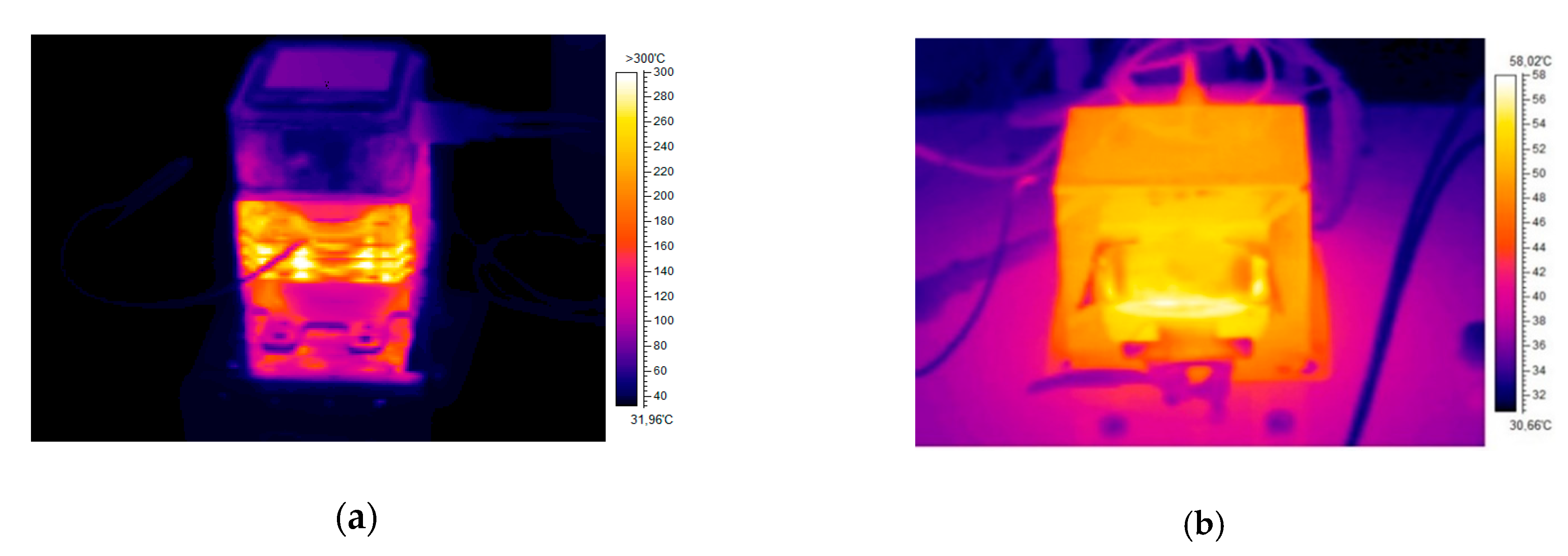

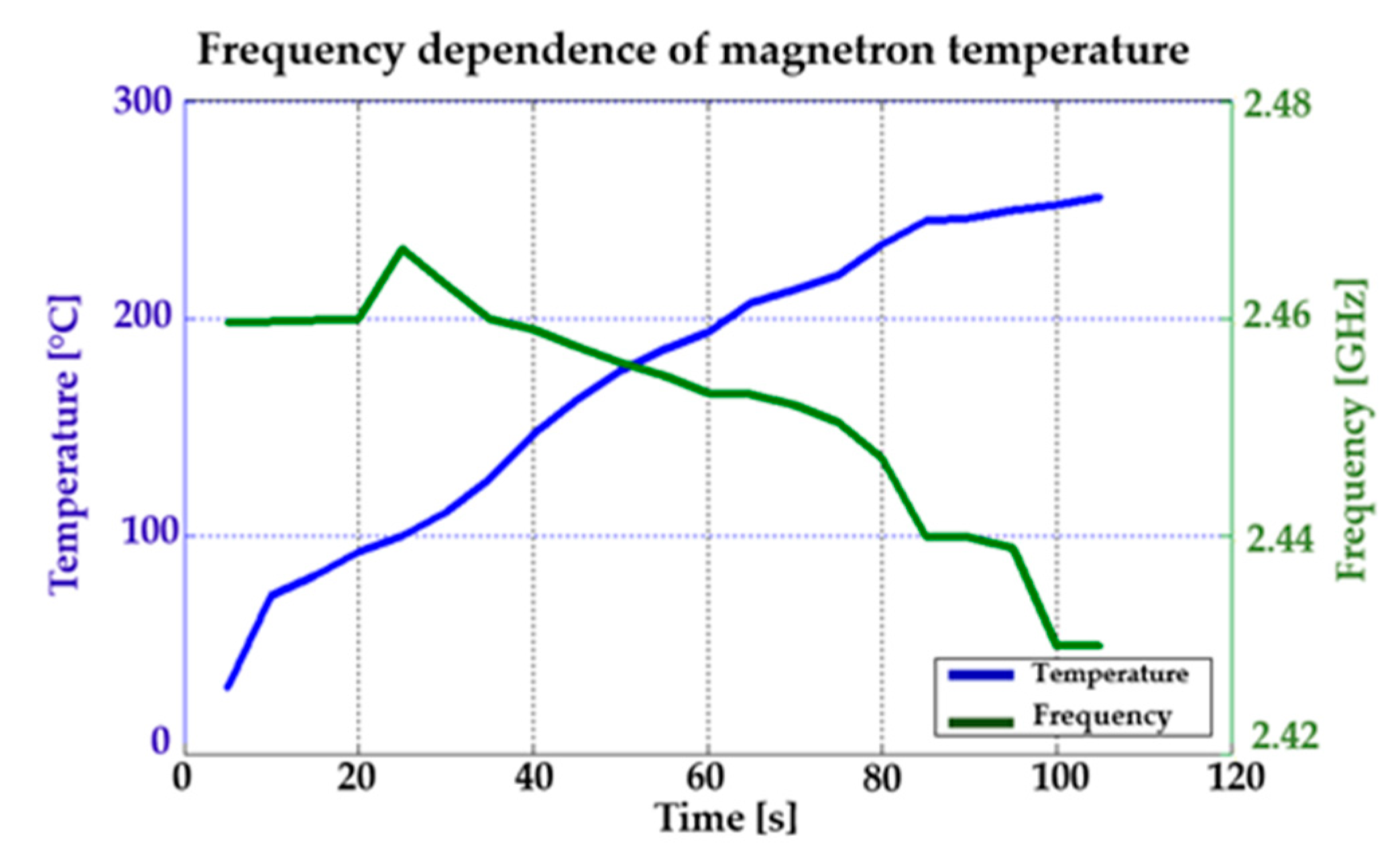
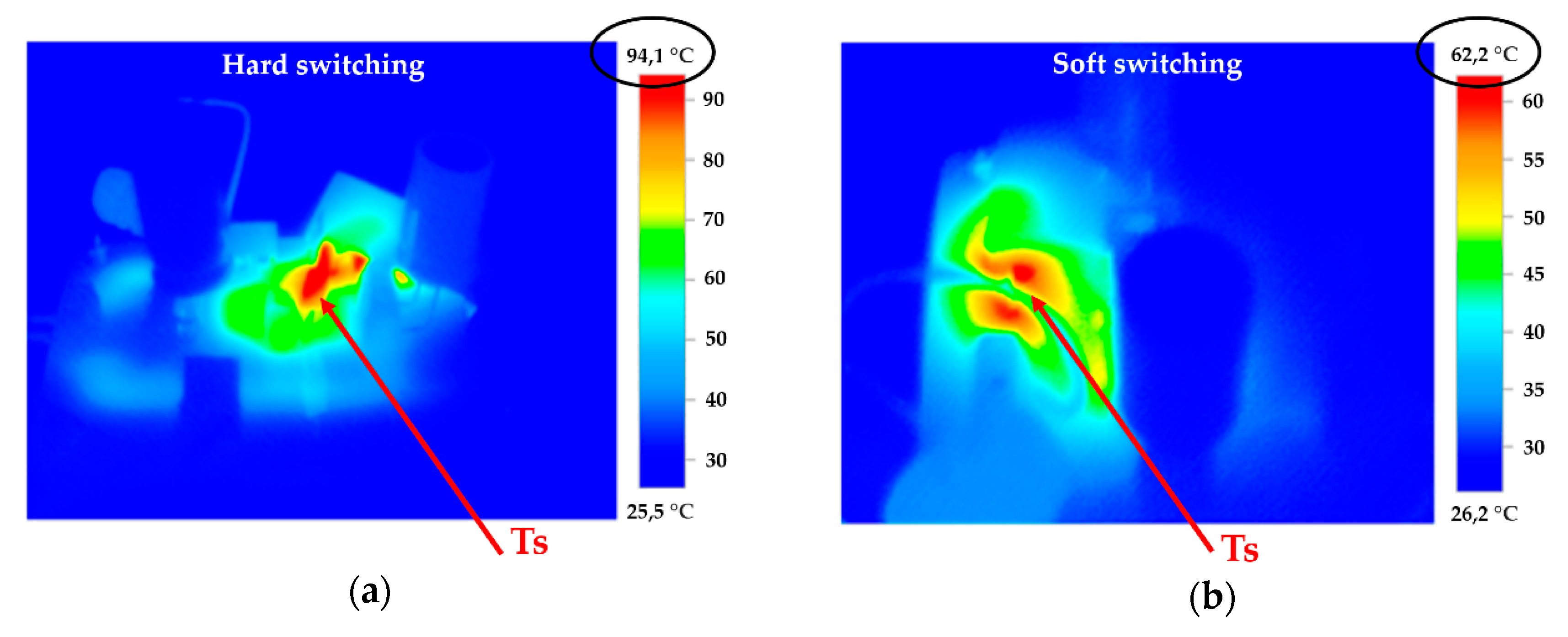

| Antenna | Gain [dB] | Width of Main Volume on E level [°] | Width of Main Volume on H level [°] | Power Density at 30m [W/m2] |
|---|---|---|---|---|
| A | 20 | 14.72 | 16.22 | 7.32 |
| B | 19 | 16.91 | 18.73 | 6.23 |
| C (Antenna 1) | 18 | 19.08 | 21.24 | 5.02 |
| D (Antenna 2) | 17 | 21.24 | 23.76 | 3.98 |
| E | 16 | 23.42 | 26.31 | 2.99 |
| F | 15 | 25.63 | 28.85 | 2.02 |
| Connection | Torque [Nm] | Rated Phase Current [A] | Phase Induction [mH] | Phase Resistance [Ω] | Nominal Step [ °] | Weight [kg] |
|---|---|---|---|---|---|---|
| Series | 7 | 2.9 | 16.4 | 1.5 | 1.8 | 3 |
| Parallel | 7 | 5.8 | 4.1 | 0.375 | 1.8 | 3 |
| Antenna | Powering the Magnetron | Driving the Motor |
|---|---|---|
| 2% | 15% | 3% |
| 20 s | 4 min | 30 s |
| Magnetron’s Power Source | Interference Length [min] | Converter Efficiency [%] | Weight [kg] | Total Efficiency [%] | Interference Distance [metres] |
|---|---|---|---|---|---|
| Converter with MOT | 12 | 57 | 8 | 49 | 0-85 |
| Resonant converter | 17 | 87 | 1,8 | 76 | 0-100 |
Publisher’s Note: MDPI stays neutral with regard to jurisdictional claims in published maps and institutional affiliations. |
© 2020 by the authors. Licensee MDPI, Basel, Switzerland. This article is an open access article distributed under the terms and conditions of the Creative Commons Attribution (CC BY) license (http://creativecommons.org/licenses/by/4.0/).
Share and Cite
Popela, M.; Leuchter, J.; Olivová, J.; Richterová, M. Development of a Remote-Controlled Electrical Interference Vehicle with a Magnetron. Sensors 2020, 20, 6309. https://doi.org/10.3390/s20216309
Popela M, Leuchter J, Olivová J, Richterová M. Development of a Remote-Controlled Electrical Interference Vehicle with a Magnetron. Sensors. 2020; 20(21):6309. https://doi.org/10.3390/s20216309
Chicago/Turabian StylePopela, Miroslav, Jan Leuchter, Jana Olivová, and Marie Richterová. 2020. "Development of a Remote-Controlled Electrical Interference Vehicle with a Magnetron" Sensors 20, no. 21: 6309. https://doi.org/10.3390/s20216309







